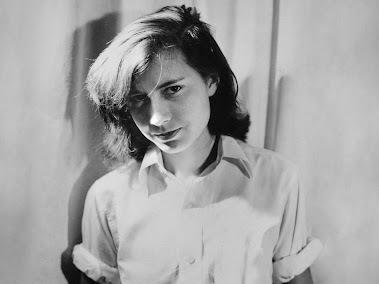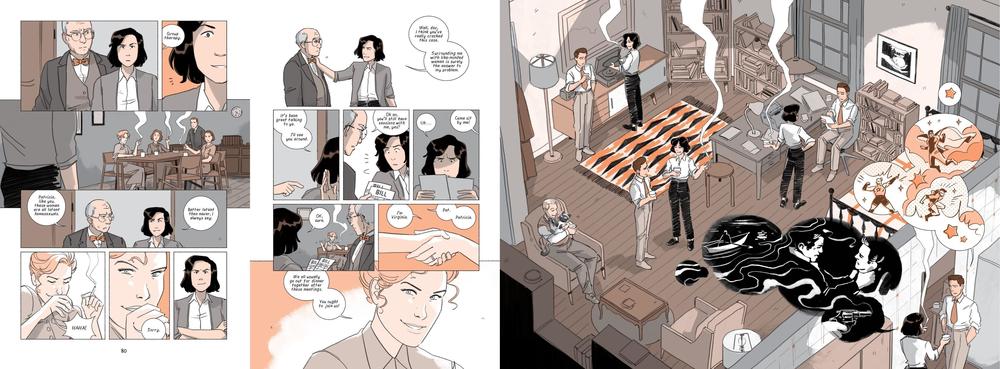Section Branding
Header Content
Untangling the contradictions of crime novelist Patricia Highsmith
Primary Content
In Alfred Hitchcock's 1951 movie Strangers on a Train, a man strikes up a conversation with a seatmate, leading to an indecent proposal. In Anthony Minghella's 1999 film The Talented Mr. Ripley, a grifter befriends a spoiled playboy, then offs him when the relationship gets complicated.
Literary critic Terry Castle says most people know Patricia Highsmith's writing through screen adaptations, but her original stories are even more chilling and compelling. "The main characters do not make sense. They seem to behave irrationally at certain points, rationally at other points. They do good things and then they do absolutely horrific things."
The same might be said of Highsmith. Her story begins in Fort Worth, Texas, in 1921. Abandoned by her father in infancy, a love-hate relationship with her mother left deeper scars. As Castle explains, "Her mother was very ambivalent about having her in the first place, and one of Highsmith's favorite stories to tell was that her mother had tried to abort her by ingesting turpentine."
As a student at Barnard College, Highsmith wrote short stories. Rebuffed by the literary establishment, she initially made her living writing comic books, which she considered akin to writing B-movies. Caped superheroes didn't align with the world of smoke and shadows, code words and double-identities that drew her interest.
When she wasn't writing, Highsmith frequented bars like Spivy's Rooftop, where Bertha Levine, also known as Madame Spivy, entertained a mix of New York's gay and literary worlds with an air of discretion.
"Highsmith was very beautiful as a young woman and charismatic," Castle says, "and she was enthusiastically homosexual, but at the same time that feeling was counterbalanced by shame and guilt."
Two years after Highsmith's 1950 debut novel Strangers on a Train became a bestseller, she wrote The Price of Salt, a lesbian love story between a glamorous housewife and a young shopgirl inspired by her own chance encounter with a customer at a department store where she had taken a holiday job.
Rather than ending in murder or marriage, the protagonists got away with the possibility of a happy ending — a first in an era where lesbianism was considered deviant, even criminal. To safeguard her career, Highsmith published the book under the alias Claire Morgan, not officially claiming it as her own until it was republished as Carol in 1990.
The original paperback became an underground classic, selling more than a million copies, but mainstream fame eluded her. Swiss filmmaker Eva Vitija says Highsmith had more in common with Dostoyevsky than Mickey Spillane. "In the U.S. she was kind of put into the box of mystery and crime novelist and her writing didn't really fit that."
Starting in the early 1960s, Highsmith zigzagged across Europe, writing, drinking and pursuing ill-fated affairs. Throughout her career, Highsmith would write more than 20 novels as well as short stories, essays and articles. She also kept voluminous notebooks and diaries.
Highsmith's final years were spent in Switzerland, where she lived in a brutalist bunker of her design with her many cats, snails and disappointments. She died from cancer in 1995, before the resurgence of interest in her work sparked by the 1999 film adaption of The Talented Mr. Ripley and then Todd Haynes' 2015 adaption of Carol. Today there is even an online "choose your own Highsmith" book recommendation engine.
At the same time, Highsmith's legacy has been tarnished by a series of unflattering posthumous disclosures in biographies by Andrew Wilson (2003), Joan Schenkar (2009) and Richard Bradford (2021), as well as the 2021 publication of selections from her diaries and notebooks — 1,000 pages whittled down from some 8,000 pages that had been tucked away in her closet.
Some of those pages reveal a bitter, hateful woman whose rants are filled with racism, antisemitism and misogyny. Yet filmmaker Eva Vitija says that person contradicts another Highsmith she saw there, a hopeful, romantic writer in perpetual search of love. Intrigued, Vitija set about finding some of Highsmith's former lovers. Her documentary Loving Highsmith, which opens in theaters next month, pairs Highsmith's diary entries with the testimony of those paramours, such as the writer Marijane Meaker, who says Highsmith was "easy to love, let's put it that way."
In contrast, Grace Ellis and Hannah Templer's new graphic novel, Flung Out of Space, points to other evidence, such as an annotated "love chart" that Highsmith once used to rank her conquests, to arrive at a different conclusion. The medium Ellis and Templer use to tell her story rubs up against Highsmith's fraught history with comics. Her bigotry is addressed head-on in the book's forward, with Ellis noting that leaning into the subject's complexity is essential to recognizing her humanity, however flawed.
One panel shows Highsmith seeking conversion therapy to cure her attraction to women; another shows her picking up women in the group therapy sessions. Ellis explains that Highsmith's shame and subversion were both fueled by societal blinders. "How many groups could you possibly be in as a lesbian in the '40s and '50s and know for certain that everyone in that group is also a lesbian?"
Copyright 2022 NPR. To see more, visit https://www.npr.org.


